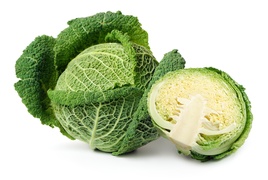
SAVOY CABBAGE
A cabbage recognizable by its green, crinkly outer leaves. The name comes from its place of origin, the region of Savoy in the western Alps. The cabbage can be shredded in salad, steamed (as in stuffed cabbage leaves) or fried.
Keep in mind
The darker leaves need to be cooked before eating.
How to cook savoy cabbage
Savoy cabbage tastes best of all when warm but the inner leaves can be shredded raw and used in a salad. Otherwise, braising, pickling and stir frying are good techniques to go for.
If you’re putting it in a salad, parboil the cabbage quickly. Cool it down and drain before adding to the salad.
Braising savoy cabbage: Slice the cabbage into chunks, brown in a casserole and add stock or cider. Simmer until soft and add some apple towards the end.
Savoy cabbage makes good sauerkraut: Slice the cabbage thinly, very thinly. Add salt and spices. Press the vegetable down so the salt is absorbed. Pack into a glass jar (it’s important that there aren’t any air bubbles left) and store at room temperature for two weeks. After that store your sauerkraut in the fridge. It will be best after a month but lasts for up to a year.
This type of cabbage goes well in a stir fry, shredded or chopped.
Oven-baked savoy cabbage is excellent with goat’s cheese and mushrooms. Put them together and see what happens.
The classic
Stuffed cabbage. (Not a pretty name for a dish, but you can pack almost any flavors you want in there.)








